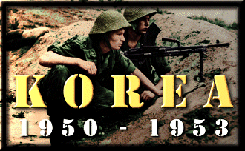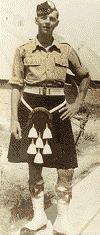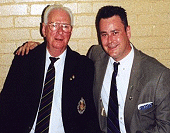Friendly Fire on Hill 282
1st Argyll and Sutherland Highlanders September 1950

On the 22nd of September 1950 the 1st Battalion of the Argyll and Sutherland Highlanders moved across the Nantong River to support the left flank of a new American offensive against the North Koreans. Lieutenant-Colonel Leslie Nielsen who had arrived in Korea in August from Hong Kong commanded the Battalion. At this time, the only Commonwealth forces in Korea were two battalions of the 27th Brigade, under Brigadier Coad. These were the Argylls and the Middlesex Regiment. On Friday the 22nd September 1950, the Argylls moved off into their first real action of the war. They were to support the left flank of Walker's breakout attempt. In particular they were to assault and capture Hill 282.
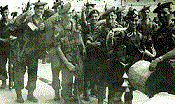
By nightfall on Friday, they were at the base of Hill 282 and the infantry dug in. The Americans had promised artillery for the next day's attack and while the Argylls attempted to get some sleep, Brigadier Coad brought up more ammo and food. At 4am, the attack company was roused and started up the hill tracks. As the sky lightened, enemy automatic weapons began to chatter and the mortars fired. Major Kenneth Muir, (who's father had commanded the 1st Battalion of the Argylls in 1923) was second in command of the Battalion, was at the Battalion Headquarters on Point 148. Muir suggested that he take command of the second body of men who were being readied to replace the casualties, and Coad agreed. Muir set off with his thirty men.
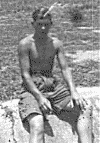
By 9am, on the morning of 23rd September, the Argylls had achieved their objective and settled down in the abandoned enemy gun pits. Gaining a little respite, some managed to find water to wash in and a few cans of food. Soon after, enemy guns began chattering and mortars began to range in on the Argylls positions. Shells slammed into the side of the hill and mortar shells tumbled out of the sky. The Korean mortar bombs and shells were pouring down on the Argylls. Not all the men on the Hill that day were veterans who had been under fire before. Some of the men in the Battalion were only teenagers serving their national service. Davie Simpson remembers the attack on Hill 282: " We set off early in the morning and took the hill in record time. When we got to the top we put out our air recognition panels. We were told to dig in but the hill was like concrete.
The American forward observers were too far away to direct their own guns' fire, and one suggested whistling up a de Havilland Mosquito reconnaissance aircraft to spot for them. Meanwhile, the Argylls were being pounded, over half the party led by Major Muir was already lost, and there were too many casualties for the bearers to take away. The US 24th Infantry Division informed the Jocks that their guns were more urgently needed elsewhere and were being moved to another location. The Americans reassured the Scots that the guns would cover them until relief guns were found. It was a simple untruth as the guns were already moving out.

The Argylls, meanwhile, were throwing back waves of North Koreans covered by a heavy barrage of artillery and mortar fire. But they were running low on ammunition, stripping their injured and dead of spare magazines as the officers and NCOs exhorted them to make every shot count. Once again they requested ammunition and artillery support, but neither was forthcoming. In the meantime the Jocks had identified the main North Korean centres from which they were being attacked and agreed to call for an air strike. They put out their air recognition panels. The officers and NCOs, who had served in the Second World War, had great faith in close air support as the RAF and USAF rarely left them down, but they didn't trust the bombers, which were notoriously inaccurate.
According to the Court of Enquiry after the event, the North Koreans were wise to the UN's tactics and put out recognition panels of their own. However, after talking to Richard Peat, a veteran of the Battle of Hill 282, the webmasters have discovered that the Argylls recognition panels were Red/Yellow or Crimson & Gold, the correct colours of the day, where as the North Korean laid out white recognition panels.
A US spotter plane had arrived and reported back to the US airfield that the Allied troops were on a ridge-like feature. The ground controllers took his word for it and launched the strike.
Shortly after midday the Argylls hearts leapt when they heard the engine roar of 3 USAF P-51 Mustangs approaching the hill. The aircraft circled the hill three times before they came screaming in to attack not the North Koreans, but the Argylls! The P-51 Mustangs poured streams of 20mm shells into the Argylls position. As the P-51s pulled out of their dive, they released their eggs. Napalm smashed into the hilltop and ammo started exploding as the fire boiled over the hillside.
Major Muir and his troops tried desperately waving the recognition panels at the American pilots but it was no use. Within a matter of two minutes Hill 282 had become an inferno. The napalm - jellied burning petrol designed to cling to its target - did its job with ruthless efficiency. The Americans had first used napalm during the Pacific Campaign in W.W.II to clear Japanese defenses.


In just two minutes the so-called friendly fire from the American planes had virtually wiped out B Company. The lucky ones were the 17 soldiers who died instantly in the attack. But 76 others suffered horrifying burns in the inferno. Gerodie Shearer, 19 years old at the time remembers trying to help his friend Davie Simpson who had been badly burned. " He was just lying there covered in burns so I gave him a cigarette. He took a puff and when I tried to take the cigarette from his mouth, his lip came away with it" Davie Simpson was lucky enough to survive his terrible injuries. Davie has a few memories of that terrible day: " We set off early in the morning and took the hill in record time. When we got to the top we put out our air recognition panels. We were told to dig in but the hill was like concrete. The next thing I knew was that we were covered in flames. I rolled down the hill so far and then walked. The skin on my arms was hanging in sheets. I must have passed out because the next thing I remember is waking up on a stretcher in an American aid post. From there I was sent to Osaka in Japan." Davie never forgot how Gerodie Shearer tried to help him on that day and they remained great friends since. Sadly Gerodie passed away recently.
Douglas Haldane was the Battalions medical officer at the time. He had the terrible task of trying to save those terribly mutilated men. He remembers: " A number of the Jocks who were still alive were very badly burned. We used intravenous plasma, which was very unusual for us. But the guys who perished were in a real mess. Eighty per cent of their body's were covered in burns. Haldane's medical sergeant Dougie Cooper remembers that terrible day. " We were left to pick up the pieces. Napalm burns the skin. When the US planes used it on the North Koreans, we often heard them screaming to die.

The survivors, blackened, with skin bursting from the heat, struggled to bring down their dead, dying and wounded. It was too much. Having realized what had happened, the North Koreans charged and one lone Jock arose form the flames taking shots at the North Koreans. Private Watts kept the attackers at a distance and Major Gillies gathered a handful of soldiers and tried to aid Watts. Major Muir, one of the survivors, decided that the charred and smouldering hilltop must be immediately re-occupied. Collecting about 30 Argylls, with a cheer, he lead them back up that terrible hill under heavy enemy fire. The North Koreans were already attacking from three points and Major Gordon-Ingram with six other Argylls gave covering fire to fourteen others gathering ammunition as Major Muir himself fired the company's sole remaining 2-inch mortar.
The Jocks were now heavily outnumbered and the mortar was hit. As the North Koreans charged again, Muir reeled to one side gravely wounded. The Argylls fought back and somehow drove the Communists back. Major Muir was still shouting encouragement and advice until finally he was hit again by two bursts of automatic fire, mortally wounding him. His last words were, " The Gooks will never drive the Argylls off this hill". He was 38 years of age when he died.
For his actions at Hill 282, Major Kenneth Muir was awarded a Posthumous Victoria Cross and the American Silver Star for gallantry. Sgt. Major Tom Collet also won the Military Medal for his courage on Hill 282. The Argyll's casualties on that day were 17 killed or missing and 76 wounded leaving the Battalion with only two rifle companies.
An American Tanker Pays Tribute to the Argylls
By Herman Hall
24th Recon Company of the 24th Infantry Division
I have wished for fifty-one years to have an opportunity to convey my admiration to the Argylls for their bravery and fighting spirit, both before and after that tragic air strike on Hill 282. In addition, it is my opinion that we owe more to those who were involved than just the stories I have read.
That said, let me write one short note. As my unit was dodging mortar shells and helping our wounded, the Argylls were coming down the road, about nine hundred yards or so from Hill 282 and as the lead men were within ten feet of where I was standing one of the men was hit and just as quickly a few others covered his body. I asked why they covered him and the reply was, "We cover our guys when they get hit. That way they have a better chance of surviving if only being hit once". That is when I realized these guys really had it!
Until that time I was a little in doubt because just prior they were all singing the song "If I knew you were coming I would of baked a cake". Those five American tanks mentioned in one of the stories belonged to the 24th Recon Coy of the 24th Inf. Div. and had been in Korea since 4 July 1950. A unit I would say was as good as any unit in Korea and had the terrain been different our tanks would have given support. All we could do was witness the events. I did see the panels and they were the right colour, (I use the colour orange) which the Argylls displayed on the Hill, and watched in horror as the three P-51 Mustangs strafed and napalmed the troops. That was one of the saddest days of my life and I know every man in my company on that day will never forget.
Not forgotten, never.
God Bless,
Herman Hall
24th Recon Coy of the 24th Inf. Div.
Jacksonville, Fl. USA
British Newspaper report of the Battle published the day after Hill 282
U.S. fire bombs
Hit 150 Argylls
Mistaking the position of British troops in South Korea, U.S. planes yesterday swooped down on them with firebombs and machine guns.
About 150 men all believed to be Argyll and Sutherland Highlanders- were killed or wounded.
The accident happened after two companies of the Argylls, operating with the Middlesex Regiment, had captured a hill two miles southeast of Sonju, west of the Naktong River.
To relieve pressure the British 27th Brigade called for an air strike.
The U.S. planes went in to attack the Reds with napalm (jellied petrol bombs), but these were dropped too far back in spite of huge recognition panels laid out by the Argylls.
New York radio stations said news agency photographer Gene Herrick saw the attack from a forward command post 400 yards away.
'Officers lost'
Many of the British were angry but Private Arthur Holmes of Claypool-Place, Liverpool, told Herrick, "this is just something that could not be helped, up to now the Yank air had given us very good support,"
Private John Grant of Glasgow who was slightly wounded said: " the better part of two companies were hit - and several officers lost. "
Herrick heard Private Stanley Williamson of Birmingham tell an officer: " it was hell up there sir."
When a half-hour later, the Communist themselves attacked the Argylls the British called for artillery support but none was available. The Americans had already withdrawn their guns.
Korean dispatches say it was a tough day for the 27th Brigade, up against the crack North Korean Third Division, but they continued their advance through the hill around Songju.
Argylls drive on
The British began their push westward early yesterday morning, with the Middlesex men moving into the Battle first. Their first objective was a hill on which the Communists were solidly entrenched. By afternoon the Reds were scurrying down the opposite slope.
Then it was the Argylls turn to attack the hill and ridges on the left. By nightfall they had taken one of their objectives and still moved forward in moonlight.
Little progress was made yesterday in and around Seoul. The southern prong is bogged down in the bitter street fighting.
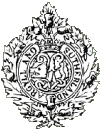
Fifty years later there is still great controversy over who is to blame for the disaster on Hill 282. Soon after the battle there were whispers that USAF officers met with the Argyll's CO Col. Neilson to apologize. But nothing was ever said to the Jocks. There was even talk of one of the pilots committing suicide for what he had done. Below is an article taken from the Sunday Mail January 31st 1993. In the article the writer Angus MacLeod reveals the possibility of a cover up concerning the Friendly Fire on Hill 282.
The British Government has decreed the details of Hill 282 must be kept a secret from the nation until the year 2025. Under the Freedom of Information rules, Americans have been told of this dark deed.

